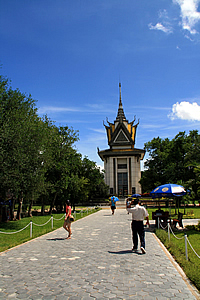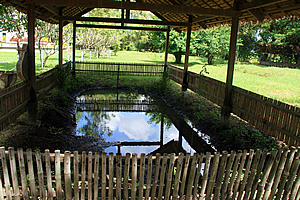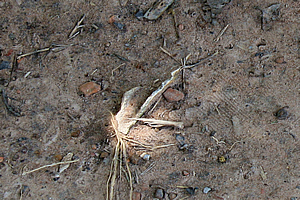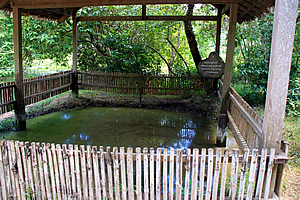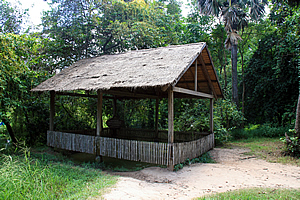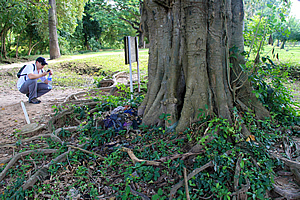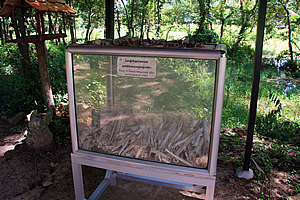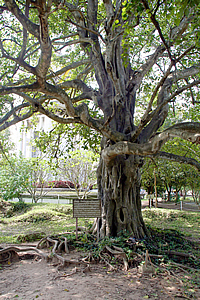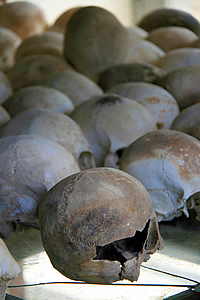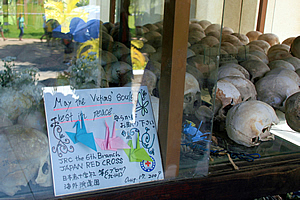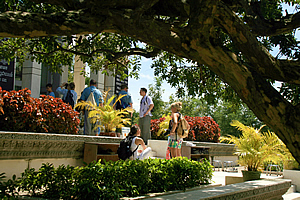--- Archive files ---
Home > Travels > Phnom Penh > 4 |
The Temple of Skulls in the midst of murky Pools
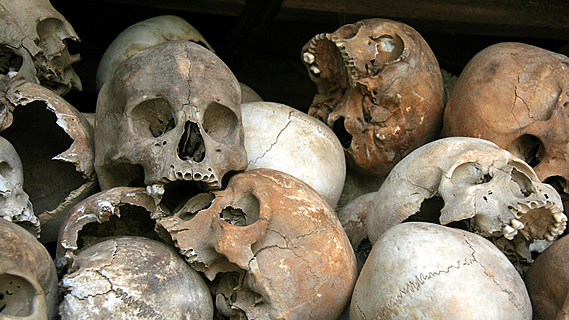
FROM Tuol Sleng we drove seventeen kilometres south of Phnom Penh to what appeared to be a large park with a high white fence around it. A fancy entrance similar in style to a Buddhist temple was marked with the inscription “Choeung Ek Genocidal Centre”. In the middle of the entrance was a barred golden gate wide enough to drive though, but it was locked. To either side was a narrow pedestrian gate of which the right hand side one was open. We left the van and walked through the entrance into the immaculately landscaped grounds.
Choeung Ek Genocidal Centre |
Our guide Ponleak led us on this tour has he had done at Tuol Sleng.
Before the Khmer Rouge, this was the site of a very peaceful orchard with a small Chinese graveyard. It would have been a very tranquil place to visit, and a beautiful place to work. That all changed in 1975.
The Khmer Rouge executed around seventeen thousand people here between 1975 and 1979, all of whom had been prisoners at Tuol Sleng.
A wide grey cobbled path led towards a recently built glass temple with a Buddhist style roof overhead. A white single chain fence was at either side of the path to keep people from walking on the immaculately green overgrown grass. To our right was the ticket controller sitting under a blue sun umbrella. Ponleak went up to him and produced our tickets.
"Mass Grave of 450 Victims" |
We turned right along a path just past the ticket controller and followed it towards a steep roof building with ornate flourishes. We didn’t approach the building though. Instead we turned left and followed a rough path through the grass continuing past the large temple to a tree with four park seats around it and a sign in front beside the path. The sign was brown with white writing and had a red Buddhist roof over the top of it. The sign read:
TRUCK STOP
Here, was the place where a trucks transporting victims to the exterminated from the Tuol Sleng prison and other places in the country, stopped. Trucks would arrive 2 or 3 times a month or every 3 weeks. Each truck held 20 to 30 frightened, blindfolded and silent prisoners.
When the trucks arrived, the victims were led directly to be executed at the ditches and pits or were set to be detained in the darken and gloomy prison nearby.
After January 07, 1979, one truck remained, but it has since been taken away.
Human bone sticking out of the ground. |
This is where the prisoners from the genocide museum had been taken to for execution.
The tree behind the sign had a large white sign saying “Quiet Please!” and a small white letterbox underneath it, perhaps for donations. Our guide showed us a nice palm tree, but explained it had been used in the torture of the prisoners.
A couple of small chickens walked around the ground pecking into the long grass as we approached a small picketed fenced area. The fence had a gazebo roof covering a large pool of mirror smooth stagnant water. The purpose of the roof seemed to be self-defeating. It had a wooden cut trunk sign with white writing on it saying:
Mass grave of 450 victims.
"Mass grave of 166 victims without heads." |
This was just one of the many mass graves containing a total of 8895 bodies so far discovered here. Knowing there were so many bodies in there gave the covered pool an incredibly eerie feeling to it. There were no dead faces in the water, but sheer horror emanated from this pit, as if in anticipation of a ghoulish zombie arm suddenly coming out and grabbing some unsuspecting tourist and dragging them into the mire. The hollow containing the pool had been from the slumping of the ground after the bodies had been buried.
We continued walking silently along the path, seeing human bones sticking out of the soil. I particularly remembered one hollow limb bone broken with the hollow showing. There must be thousands of people randomly buried here.
"Mass grave of more than 100 victims children and women whose majority was naked." |
We reached another similar building with a shallower pool. This one had dark slime in the shallow stagnant water - I could see the miry bottom. The wooden log sign said:
“Mass grave of 166 victims without heads.”
I wondered how they knew how many bodies had been buried there. Did the killers keep records, or had the mass graves been x-rayed?
There was a natural swamp behind the mass grave. Our guide explained many bodies were dumped there, and that the occasional body would surface from its murky depths to this day.
"Killing tree against which executioners beat children." |
We passed a tree with numerous coloured articles of clothing showing the prisoners had been stripped naked and hung on the tree to die. Small green plants grew in amongst the clothing. We walked around another hollow in the ground filled with muddy water. No doubt this was another mass grave. The path followed a small maze around several more of these pools, each no doubt holding the decomposing remains of the tortured souls of anyone who had dared resist the Pol Pot regime.
We reached another fenced and roofed mass grave. This one had the sign:
"Mass grave of more than 100 victims children and women whose majority was naked."
I’m not sure if that meant most of the people here had been executed naked, or whether they were all half naked wearing only rags. We passed several more pools of water in the ground and curiously there were a couple of park benches.
Box of human bones |
We reached a large tree leaning over about ten degrees. There was a sign at the bottom of it saying:
"Killing tree against which executioners beat children."
Near the killing tree stood a small square roofed gazebo roof covering a glass rectangular box propped up on a four legged wooden stand. The box contained bones that had been dug up in an excavation in 1980. Most of the bones were broken pieces of limb bones, but inside there was also a glass jar full of teeth.
"Magic tree. The tree was used as a tool to hang a loudspeaker which make sound louder to avoid the moan of victims while they were being executed" |
A solitary small tombstone with the inscriptions almost completely gone stood next to the gazebo. We then reached a large gnarly knotted fig tree looking ominous. It had a sign in front of it saying:
We continued following the path meandering in amongst the long fresh grass in between the hollows of the mass graves and the occasional upended rock. We reached another large tree with many rotting clothes underneath it. It had a sign saying that this was where many victims were hanged.
"Magic tree. The tree was used as a tool to hang a loudspeaker which make sound louder to avoid the moan of victims while they were being executed"
The trail left the forest coming out behind the tall temple we had seen from the entrance. The temple is a Buddhist stupa in a formal square shape with two layers of landscaped gardens with small golden cane palms and several shrubby broadleaf plants. The walls of the temple were white and there were glass sections in the middle.
A large black sign read:
Skulls
Would you please kindly show your respect to many million people who were killed under the genocidal Pol Pot regime.
This was considered a holy place where shoes needed to be removed. There were a few small white pots of plants outside the small entrance.
I entered the temple and saw through the glass more than five thousand skulls sitting on layers of glass shelving. Many of the skulls had been smashed in the side no doubt by blunt force. Their eyes stared the blank stare of death. There were piles of clothes in the lowest level, and a memorial of letters and origami cranes put together by a Japanese group.
The paper cranes were a Japanese peace symbol used in funerals. They had been made famous when many were made in memory of those killed in Hiroshima and Nagasaki. They were used here.
"May the victims’ souls rest in peace. JRC the 6th branch, Japan Red Cross, August 17 2009" |
In front of the glass was a large blue donations box. There were numerous origami cranes. Some skulls had a written code written on their side, codes such as IK417. Perhaps these had been identified, or maybe they were the prisoner number. The Japanese sign read in child writing:
There were ten layers of skulls up the height of the tower, and one layer at the bottom of clothes. Each layer of skulls represented a different age group and gender. The level I looked into contained the skulls of fifteen to twenty year old women who had been executed here. The clothes had been recovered from an excavation in 1988. There were about eight thousand skulls in here – about half of the number of people executed here. Despite the place being so tranquil, it was deathly eerie, no doubt haunted by the ghosts of the souls of those who had been tortured and executed here by the Khmer Rouge.
People entering the temple of skulls |
We left the genocide centre and returned back through the city. I was amazed at the number of people wearing thick jackets that covered their skin in such hot conditions. The temperature must be in the high thirties again. This must be to keep their skin pale.
It now became more apparent that the people over the age of about thirty all looked haggard and unhappy. They were the survivors of the revolution. In stark contrast all the people under the age of thirty seemed to be incredibly happy. They had not had the misfortune of having survived all the killings.
<< Previous | Next >> |
|
||
About this Page
|
||
|
|
|
Where is Walkabout Jeff? |
|
|
|
|
What is happening in Walkabout Jeff's hometown?
|
|
|
|
|
Who is Walkabout Jeff?Any normal person's idea of going out involves going to the local pub for a drink with a few mates. Walkabout Jeff isn't normal.
|
|
|
|
|
